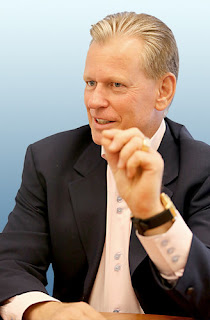Yo sufro de algo llamado enfermedad de Ménière, pero no se preocupe, no se contagia con la lectura de este post. Los síntomas de la enfermedad de Ménière incluyen pérdida de la audición, tinnitus (un zumbido constante) y vértigo. Hay muchas teorías médicas sobre su causa: exceso de sal, cafeína o alcohol en la dieta, el exceso de estrés y las alergias. Por lo tanto, he trabajado para limitar el control de todos estos factores.
Sin embargo, tengo otra teoría. Como inversor de capital de riesgo, tengo que escuchar a cientos de empresarios en lapresentación de sus emprendimientos. La mayoría de estas presentaciones son basura: Sesenta diapositivas sobre: "Una patente pendiente", "La ventaja de ser el primero", "todo lo que tenemos que hacer es conseguir un 1% de la gente en China para comprar nuestro producto" para comenzar. Estas presentaciones son tan malas que estoy perdiendo la vista, tengo un zumbido constante en mi oído, y de vez en cuando el mundo comienza a girar.
Para evitar una epidemia de Ménière en la comunidad de capital de riesgo, estoy evangelizando conla Regla 10/20/30 de PowerPoint. Es muy simple: una presentación en PowerPoint debe tener diez diapositivas, que no duren más de veinte minutos, y que no utilicen ningún tipo de letra de tamaño menor a treinta puntos. A lo largo del tiempo que llevo en el negocio de capitales de riesgo, esta regla se aplica para cualquier presentación para llegar a un acuerdo: por ejemplo, la búsqueda de capital, para hacer una venta, para formar una sociedad, etc.
- Diez diapositivas. Diez es el número óptimo de diapositivas en una presentación de PowerPoint, porque un ser humano normal no puede comprender más de diez conceptos en una reunión y los capitalistas de riesgo son personas muy normales. (La única diferencia entre usted y el capitalista de riesgo es que a él le pagan por jugar con el dinero de otros). Si tiene que usar más de diez diapositivas para explicar su negocio, usted probablemente no tiene un negocio. Los diez temas que un capitalista de riesgo le interesan son los siguientes:
- El Problema
- Tu solución
- El modelo de negocio
- Ventaja Competitiva
- Marketing y ventas
- Competencia
- El Equipo
- Proyecciones Financieras
- Situación Actual y Programa de avance
- El Resumen y la necesidad de la acción
- Usted debe exponer las diapositivas diez en veinte minutos. Claro, usted cuenta con un margen de tiempo de una hora, pero estás usando una laptop con Windows, por lo tanto te llevará cuarenta minutos para lograr que funcione con el proyector. Incluso si la configuración va perfectamente, la gente llega tarde y tienen que salir temprano. En un mundo perfecto, usted haría su exposición en veinte minutos, y tendría cuarenta minutos de sobra para el debate.
- Fuente de treinta puntos. La mayoría de las presentaciones que veo tienen texto en una fuente de diez puntos. Se ha amontonado tanto texto como se pudo en la diapositiva y, por consecuencia, el presentador la lee. Sin embargo, tan pronto como la audiencia se da cuenta que usted está leyendo el texto, se hace notorio que puede leer más rápido de lo que puede hablar. El resultado es que usted y el público están fuera de sincronía.
La razón la gente utiliza una fuente pequeña es doble: primero, que no conocen su material lo suficientemente bien, en segundo lugar, piensan que el mucho texto es más convincente. Esfuérzate por no utilizar fuente más pequeña que treinta puntos. Yo le garantizo que va a mejorar su presentación, ya que le exige a usted que encuentre los puntos más importantes y que sepa cómo explicarlos bien. Si "treinta puntos", le parece demasiado dogmático, le ofrezco un algoritmo: averiguar la edad de la mayor persona de su público y lo dividen por dos. Ese es el tamaño óptimo de fuente.
Así que por favor observe la regla de 10/20/30 de PowerPoint. Por lo menos, la próxima vez que alguien en su público se queja de la pérdida de la audición, zumbido o vértigo, usted sabrá qué causó el problema.
Via: Traducido por Pablo Quiroga, con ayuda del traductor de Google

